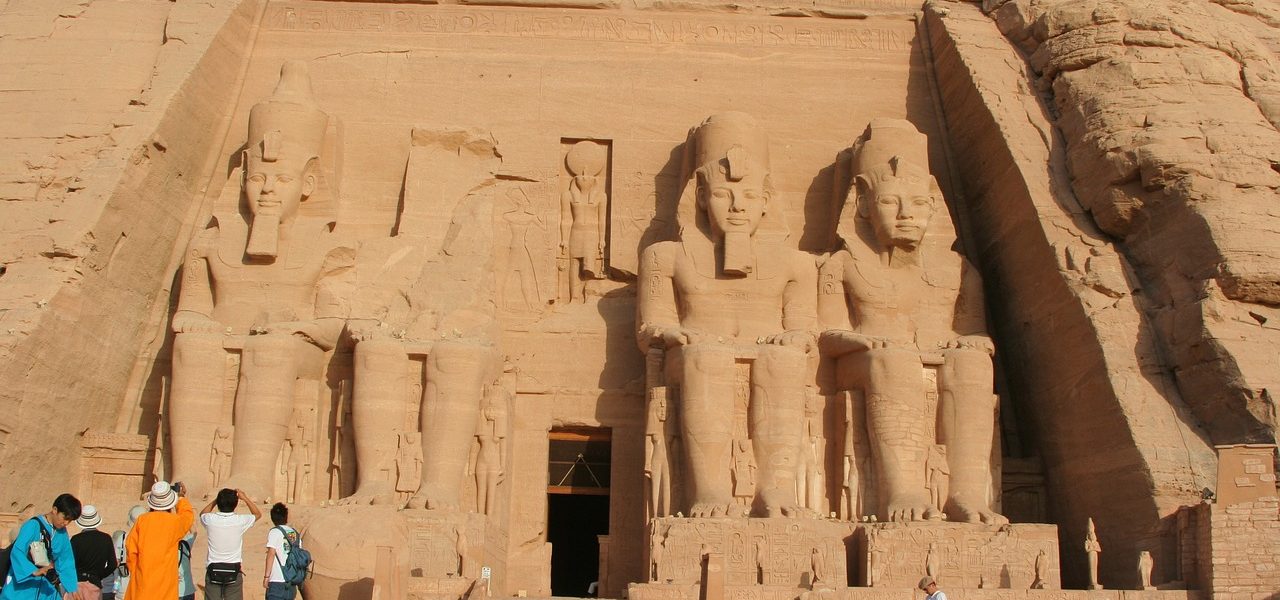Abu Simbel Temple
Step back in time and marvel at the incredible Abu Simbel Temple, a true testament to ancient Egyptian engineering and artistry. This magnificent masterpiece, located in southern Egypt on the western bank of Lake Nasser, stands as a timeless wonder that continues to capture the imagination of visitors from around the world.
Built by Pharaoh Ramses II in the 13th century BC, Abu Simbel Temple is a true marvel of architectural achievement. Carved into the mountainside, this imposing structure features colossal statues, intricate hieroglyphics, and breathtaking reliefs that showcase the skill and craftsmanship of the ancient Egyptians.
As you explore this UNESCO World Heritage site, you’ll be awe-struck by the intricate details and grandeur of the temple. From the 65-foot-tall statues guarding the entrance to the inner chambers adorned with stunning murals depicting scenes of Pharaoh’s military triumphs, every corner of Abu Simbel Temple tells a story of ancient Egypt’s rich history and cultural significance.
Journey back in time and unlock the secrets of this timeless wonder. Experience the architectural brilliance and artistic mastery that has stood the test of time at the magnificent Abu Simbel Temple.
History and significance of Abu Simbel Temple
Built by Pharaoh Ramses II in the 13th century BC, Abu Simbel Temple is a true marvel of architectural achievement. Carved into the mountainside, this imposing structure features colossal statues, intricate hieroglyphics, and breathtaking reliefs that showcase the skill and craftsmanship of the ancient Egyptians.
Abu Simbel Temple holds immense historical and cultural significance. It was constructed to commemorate Ramses II’s victory at the Battle of Kadesh and to demonstrate his divine right to rule. The temple complex also pays homage to the gods Amun, Ra-Horakhty, and Ptah. It served as a place of worship and a symbol of the pharaoh’s power and authority.
The engineering marvel of Abu Simbel Temple
The engineering prowess displayed in the construction of Abu Simbel Temple is truly remarkable. The entire complex was carved out of a single rock face, showcasing the ingenuity and skill of ancient Egyptian architects and engineers. The precision with which the temple was aligned with the rising sun is a testament to their advanced knowledge of astronomy and mathematics.
One of the most impressive engineering feats of Abu Simbel Temple is the preservation of the temple’s orientation during its relocation in the 1960s. Due to the construction of the Aswan High Dam, the temple was at risk of being submerged underwater. To save this invaluable piece of history, the temple was meticulously dismantled and moved to a higher location, ensuring its preservation for future generations.
Architectural features and artistry at Abu Simbel Temple
The architectural features and artistry at Abu Simbel Temple are awe-inspiring. The exterior of the temple is adorned with colossal statues of Ramses II, each standing at a height of 65 feet. These statues serve as guardians, protecting the entrance and symbolizing the pharaoh’s power.
Upon entering the temple, visitors are greeted with a series of intricate hieroglyphics and stunning reliefs that depict scenes from Egyptian mythology and Ramses II’s military campaigns. The attention to detail and the skillful execution of these carvings are a testament to the artistic mastery of the ancient Egyptians.
The Great Temple of Ramses II
The Great Temple of Ramses II is the main attraction at Abu Simbel. This temple is dedicated to the gods Amun, Ra-Horakhty, and Ptah, as well as to Ramses II himself. The interior of the temple is adorned with massive pillars, intricately carved walls, and stunning murals that depict the pharaoh’s military triumphs and his divine lineage.
One of the most famous features of the Great Temple is the phenomenon known as the “Sun Festival.” Twice a year, on February 22nd and October 22nd, the rising sun illuminates the inner sanctuary, lighting up the statues of the gods while leaving the statue of Ptah, the god of darkness, in the shadows. This remarkable event attracts visitors from all over the world, who gather to witness this celestial spectacle.
The Temple of Hathor and Nefertari
Located adjacent to the Great Temple, the Temple of Hathor and Nefertari is equally captivating. This temple is dedicated to the goddess Hathor and Ramses II’s beloved wife, Queen Nefertari. The exterior of the temple features six statues, four of which represent Ramses II and two representing Queen Nefertari.
Inside the temple, visitors are greeted with stunning reliefs and murals that depict scenes of the royal couple’s life and their devotion to the gods. The exquisite craftsmanship and attention to detail in these artworks are a testament to the artistic skill of the ancient Egyptians.
Preservation efforts and the relocation of Abu Simbel Temple
In the 1960s, the construction of the Aswan High Dam posed a significant threat to Abu Simbel Temple. To prevent the temple from being submerged underwater, an international rescue mission was launched. The temple was painstakingly dismantled and relocated to a higher location, ensuring its preservation for future generations.
This relocation process was a monumental engineering feat. The temple was cut into massive blocks, each weighing up to 30 tons, and transported to its new site. The blocks were then reassembled, maintaining the temple’s original orientation and preserving its architectural integrity.
Cultural and historical impact of Abu Simbel Temple
Abu Simbel Temple holds immense cultural and historical significance. It serves as a window into the rich history and cultural heritage of ancient Egypt. The temple’s architectural brilliance, intricate carvings, and stunning artworks provide valuable insights into the religious beliefs, military achievements, and social structure of the time.
The relocation of Abu Simbel Temple also symbolizes the international effort to preserve and protect our shared cultural heritage. It stands as a testament to humanity’s commitment to safeguarding the treasures of the past for future generations.




